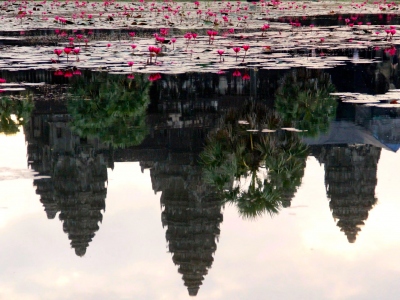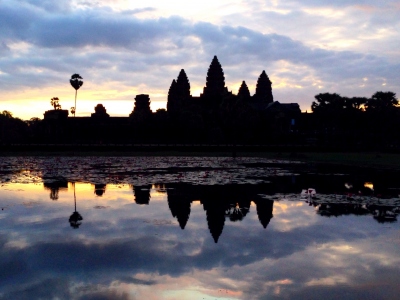Cambodia
"Kingdom of Cambodia" redirects here. For the post-independence era, see Kingdom of Cambodia (1953–70).
Cambodia (/kæmˈboʊdiə/ (About this sound listen); also Kampuchea /ˌkæmpʊˈtʃiːə/; Khmer: កម្ពុជា Khmer: [kam.pu.ciə]; French: Cambodge), officially the Kingdom of Cambodia (Khmer: ព្រះរាជាណាចក្រកម្ពុជា, prĕəh riəciənaacak kampuciə, IPA: [prĕəh riə.ciə.naː.caʔ kam.pu.ciə]; French: Royaume du Cambodge), is a country located in the southern portion of the Indochina peninsula in Southeast Asia. It is 181,035 square kilometers (69,898 square miles) in an area, bordered by Thailand to the northwest, Laos to the northeast, Vietnam to the east and the Gulf of Thailand to the southwest.
The sovereign state of Cambodia has a population of over 16 million. The official religion is Theravada Buddhism, practiced by approximately 95 percent of the population. The country's minority groups include Vietnamese, Chinese, Chams, and 30 hill tribes.[8] The capital and largest city is Phnom Penh, the political, economic and cultural center of Cambodia. The kingdom is an elective constitutional monarchy with a monarch, currently Norodom Sihamoni, chosen by the Royal Throne Council as head of state. The head of government is the Prime Minister, currently Hun Sen, the longest serving non-royal leader in Southeast Asia, ruling Cambodia since 1985.
In 802 AD, Jayavarman II declared himself king, uniting the warring Khmer princes of Chenla under the name "Kambuja".[9] This marked the beginning of the Khmer Empire, which flourished for over 600 years, allowing successive kings to control and exert influence over much of Southeast Asia and accumulate immense power and wealth. The Indianised kingdom facilitated the spread of first Hinduism and then Buddhism to much of Southeast Asia and undertook many religious infrastructural projects throughout the region, including the construction of more than 1,000 temples and monuments in Angkor alone. Angkor Wat is the most famous of these structures and is designated as a World Heritage Site.
After the fall of Angkor to Ayutthaya in the 15th century, a reduced and weakened Cambodia was then ruled as a vassal state by its neighbors. In 1863, Cambodia became a protectorate of France, which doubled the size of the country by reclaiming the north and west from Thailand.
Angkor Wat
Angkor Wat (Khmer: អង្គរវត្ត or "Capital Temple") is a temple complex in Cambodia and the largest religious monument in the world, with the site measuring 162.6 hectares (1,626,000 m2; 402 acres). It was originally constructed as a Hindu temple of god Vishnu for the Khmer Empire, gradually transforming into a Buddhist temple toward the end of the 12th century. It was built by the Khmer King Suryavarman II in the early 12th century in Yaśodharapura (Khmer: យសោធរបុរៈ, present-day Angkor), the capital of the Khmer Empire, as his state temple and eventual mausoleum.














